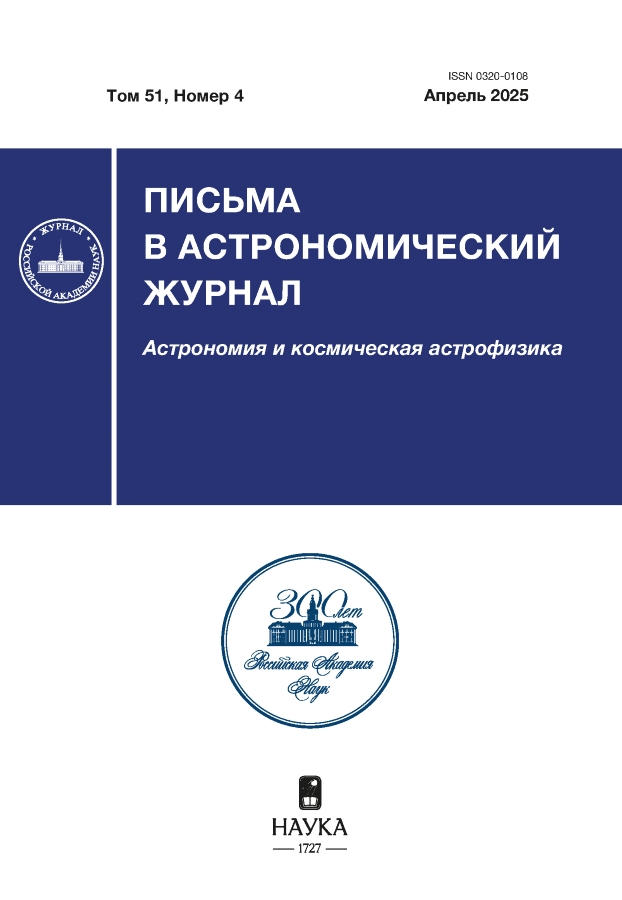Theoretical Mass Estimates for the Mira-Type Variable R Hydrae
- Authors: Fadeyev Y.A.1
-
Affiliations:
- Institute of Astronomy, Russian Academy of Sciences
- Issue: Vol 49, No 4 (2023)
- Pages: 255-263
- Section: Articles
- URL: https://rjmseer.com/0320-0108/article/view/674299
- DOI: https://doi.org/10.31857/S0320010823040022
- EDN: https://elibrary.ru/CUFEWQ
- ID: 674299
Cite item
Abstract
Calculations of stellar evolution at initial abundances of helium
and heavier elements
were done for stars with masses on the main sequence
. Evolutionary sequences corresponding to the AGB stage were used for modelling the pulsation period decrease observed for almost two centuries in the Mira-type variable R Hya. Diminution of the period from @ 495 d in the second half of the eighteenth century to @ d in the 1950s is due to stellar radius decrease accompanying dissipation of the @ diation–diffusion wave generated by the helium flash. For all the history of its @bservations R Hya was the fundamental mode pulsator. The best agreement with @ bservations is obtained for eight evolutionary models with initial mass @ and the mass loss rate parameter of the Blöcker formula @. Theoretical mass estimates of R Hya are in the range @, whereas the mean stellar radius (@) corresponding to the pulsation period @ d agrees well with @easurements of the angular diameter by methods of the optical @nterferometric imaging.
About the authors
Yu. A. Fadeyev
Institute of Astronomy, Russian Academy of Sciences
Author for correspondence.
Email: fadeyev@inasan.ru
119017, Moscow, Russia
References
- Айреланд и др. (M.J. Ireland, P.G. Tuthill, T.R. Bedding, J.G. Robertson, and A.P. Jacob), MNRAS 350, 365 (2004).
- Андриантсаралаза и др. (M. Andriantsaralaza, S. Ramstedt, W.H.T. Vlemmings, and E. De Beck), Astron. Astrophys. 667, A74 (2022).
- Асплунд и др. (M. Asplund, N. Grevesse, A.J. Sauval, and P. Scott), Ann. Rev. Astron. Astrophys. 47, 481 (2009).
- Бём-Витензе (E. Böhm-Vitense), Zeitschrift für Astrophys. 46, 108 (1958).
- Блокер (T. Blöcker), Astron. Astrophys. 297, 727 (1995).
- Вуд, Зарро (P.R. Wood and D.M. Zarro), Astrophys. J. 247, 247 (1981).
- Вудруф и др. (H.C. Woodruff, P.G. Tuthill, J.D. Monnier, M.J. Ireland, T.R. Bedding, S. Lacour, W.C. Danchi, and M. Scholz), Astrophys. J. 673, 418 (2008).
- Гульд (B.A. Gould), Astron. Nachr. 102, 341 (1882).
- Зийстра и др. (A.A. Zijlstra, T.R Bedding, and J.A. Mattei), MNRAS 334, 498 (2002).
- Каннон, Пикеринг (A.J. Cannon and E.C. Pickering), Annals of Harvard College Observatory 55, 95 (1909).
- Куфюс (R. Kuhfuß), Astron. Astrophys. 160, 116 (1986).
- Лебцельтер, Хрон (T.Lebzelter and J. Hron), Astron. Astrophys. 411, 533 (2003).
- Литтл и др. (S.J. Little, I.R. Little-Marenin, and W.H. Bauer), Astron. J. 94, 981 (1987).
- Лудендорф (H. Ludendorff), Astron. Nachr. 203, 117 (1916).
- Льюис и др. (B.M. Lewis, P. David P, and A.M. Le Squeren), Astron. Astrophys. Suppl. Ser. 111, 237 (1995).
- Меррилл (P.W. Merrill), Astrophys. J. 103, 6 (1946).
- Меррилл (P.W. Merrill), Publ. Astron. Soc. Pacific 69, 77 (1957).
- Мехара (H. Maehara), Publ. Astron. Soc. Japan 23, 313 (1971).
- Мюллер (R. Müller), Astron. Nachr. 237, 81 (1929).
- Нилсен (A.V. Nielsen), Astron. Nachr. 227, 141 (1926).
- Орлов М.Я., Шаврина А.В., Науч. информ. Астрон. совета АН СССР 56, 97 (1984).
- Пакстон и др. (B. Paxton, R. Smolec, J. Schwab, A. Gautschy, L. Bildsten, M. Cantiello, A. Dotter, R. Farmer, J.A. Goldberg, A.S. Jermyn, S.M. Kanbur, P. Marchant, A. Thoul, R.H.D. Townsend, W.M. Wolf, M. Zhang, and F.X. Timmes), Astrophys. J. Suppl. Ser. 243, 10 (2019).
- Пиньятари и др. (M. Pignatari, F. Herwig, R. Hirschi, M. Bennett, G. Rockefeller, C. Fryer, F.X. Timmes, C. Ritter, A. Heger, S. Jones, U. Battino, A. Dotter, R. Trappitsch, S. Diehl, U. Frischknecht, A. Hungerford, G. Magkotsios, C. Travaglio, and P. Young), Astrophys. J. Suppl. Ser. 225, 24 (2016).
- Раймерс (D. Reimers), Problems in stellar atmospheres and envelopes (Ed. B. Baschek, W.H. Kegel, G. Traving, New York: Springer-Verlag, 1975), p. 229.
- Сайбурт и др. (R.H. Cyburt, A.M. Amthor, R. Ferguson, Z. Meisel, K. Smith, S. Warren, A. Heger, R.D. Hoffman, T. Rauscher, A. Sakharuk, H. Schatz, F.K. Thielemann, and M. Wiescher), Astrophys. J. Suppl. Ser. 189, 240 (2010).
- Самусь Н.Н., Казаровец Е.В., Дурлевич О.В., Киреева Н.Н., Пастухова Е.Н., Астрон. журн. 94, 87 (2017) [N.N. Samus’, E.V. Kazarovets, O.V. Durlevich, N.N. Kireeva, and E.N. Pastukhova, Astron. Rep. 61, 80 (2017)].
- Такаба и др. (H. Takaba, I. Takahiro, M. Takeshi, and S. Deguchi), Publ. Astron. Soc. Japan 53, 517 (2001).
- Фадеев Ю.А., Письма в Астрон. журн. 39, 342 (2013) [Yu.A. Fadeyev, Astron. Lett. 39, 306 (2013)].
- Фадеев (Yu.A. Fadeyev), MNRAS 514, 5996 (2022).
- Фист и др. (M.W. Feast, I.S. Glass, P.A. Whitelock, and R.M. Catchpole), MNRAS 241, 375 (1989).
- Хамфрис и др. (E.M.L. Humphreys, M.D. Gray, J.A. Yates, and D. Field), MNRAS 287, 663 (1997).
- Ханифф и др. (C.A. Haniff, M. Scholz, and P.G. Tuthill), MNRAS 276, 640 (1995).
- Хервиг (F. Herwig), Astron. Astrophys. 360, 952 (2000).
- Хервиг и др. (F. Herwig, N. Langer, and M. Lugaro), Astrophys. J. 593, 1056 (2003).
- Хоффлейт (D. Hoffleit), J. Am. Associat. Var. Star Observ. 25, 115 (1997).
- Шмидт (J.F.J. Schmidt), Astron. Nachr. 65, 173 (1865).
- Чандлер (S.C. Chandler), Astron. Nachr. 103, 225 (1882)
- Яари, Тухман (A. Ya’Ari and Y. Tuchman), Astrophys. J. 456 350 (1996).
Supplementary files











